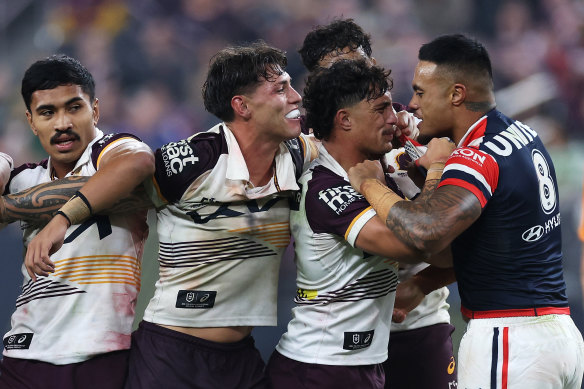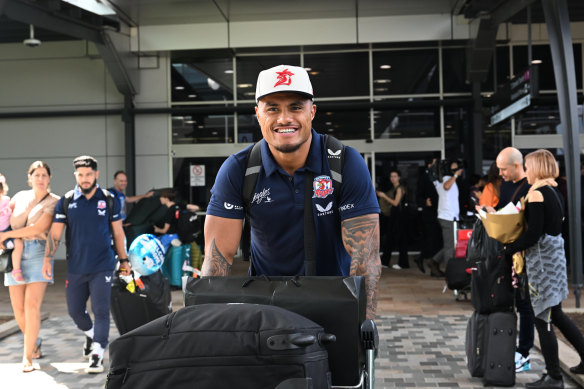
After Bellew explained the panel’s unanimous verdict, Leniu shook everyone’s hands and smiled, even though they had, in essence, also called bullshit.
For some, two months on the sidelines won’t be long enough.

Spencer Leniu (right) of the Roosters exchanges heated words with Kotoni Staggs of the Broncos.Credit: Getty
They wanted Leniu’s house, car, superannuation and part of his soul and fair enough, too, because this incident has hurt people in different ways.
But as you watched Leniu humbly and candidly give his version of events on this night, in front of a room of lawyers, officials, his coach Trent Robinson and a dozen reporters, his remorse rung true — even if that conflicts with the panel’s decision.
Racism scandals are never pretty. They are all uniquely ugly and sad in their own way. But rugby league started drawing a line on this type of vilification long ago, and you only had to peer over your shoulder during the hearing for a reminder of how far the code has come.
Loading
In the back-row of the hearing sat Dean Widders, who has worked for many years at the NRL an Indigenous Player Wellbeing and Education manager.
In another life, in 2005, South Sydney captain Bryan Fletcher called him “black c---” while Widders was playing for Parramatta. Fletcher’s punishment? A $10,000 fine and he lost the captaincy.
It took great courage for Indigenous players to call out racism then, as it does now, but the manner in which Mam immediately made an on-field complaint that night, and the way his teammates, club and fellow Indigenous players have rallied around him, demonstrates a significant shift.
The startling and raw testimony Leniu provided on Monday night showed how far there is to go.
The judiciary heard that, after tackling Broncos prop Payne Haas, Mam had said to his teammates, “Run it back at Spencer”. That Leniu’s first reaction was to say, “F--- up, you monkey” suggests it wasn’t a premeditated sledge, but a visceral response to a rival player on the blindside chirping at him.

Roosters prop Spencer Leniu put on a brave face as he returned to Sydney last Tuesday.Credit: Janie Barrett
In his subsequent post-match media interviews, in which he called the exchange as “fun and games”, and then an argument with Broncos players back at the hotel where the teams were staying, he still didn’t know how rank the term was.
The penny started to drop when he woke up and read the message from the Indigenous woman explaining how hurtful his words could be.
NRL prosecutor Lachlan Giles argued this was a “convenient excuse”. He claimed it was impossible for anyone in this country to not understand the racial implications of the term “monkey”, citing cricket’s 2008 Monkeygate scandal involving Andrew Symonds and other incidents.
“Have you not heard of Adam Goodes?” Giles asked, referencing the terrible events of 2013 when the Sydney Swans star was called an “ape” by a young Collingwood supporter at the SCG.
“No,” Leniu said.
For mine, this strikes at the heart of the argument beyond the spin and leaked stories of the past week; whether he knew the term was racist or not.
When Indian spinner Harbhajan Singh allegedly called Symonds a “monkey”, Leniu hadn’t even moved to Australia yet. He was eight years old.
Loading
When Goodes was racially vilified, he was living in Mount Druitt, immersed in rugby league. He was 13 years old.
His learned experience is different to others, to you and me, and to dismiss him when he says he genuinely didn’t know that the term “monkey” was wrong is naïve. You don’t know what you don’t know.
Leniu also gave a troubling insight into how players of colour in football teams speak to one another. He revealed that terms like “black c---“, “blackie”, “coconut” and “monkey” was “common language” in some environments.
If that’s the case, the events of the past week will surely give every club reason to pause and consider the language that is used. We all should.









 Add Category
Add Category